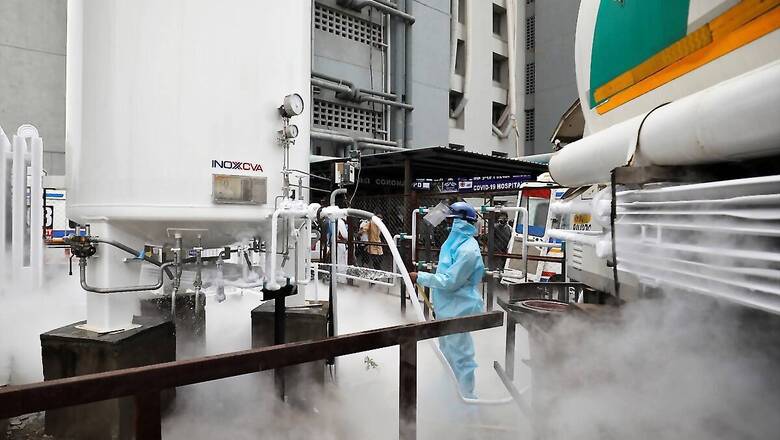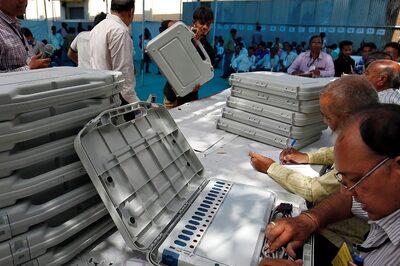
views
As the coronavirus cases in the country explode, hospitals face a perilous shortage of oxygen. In the grip of a second wave, India on Wednesday reported 2,95,041 new Covid-19 cases, a record spike seen in 24 hours. Along with the national capital of Delhi, several states, including Maharashtra, Gujarat, Rajasthan, Uttar Pradesh, have reported an ongoing or an impending oxygen shortage.
How Covid-19 Casues Shortness of Breath
Covid-19 affects the patient’s respiratory system in a way that leads to shortness of breath. The SARS-CoV-2 coronavirus can infect the respiratory epithelial cells, which protect the respiratory tract from pathogens and infections and also facilitate gas exchange in the lungs. In response to an infection in the respiratory tract, the body’s immune system releases cells that trigger inflammation. When this inflammatory immune response continues, it hinders the regular transfer of oxygen in the lungs. Simultaneously, fluids also build up, making it difficult to breathe. Low levels of oxygen caused by Covid-19 are inflammatory markers, which include elevated white blood cell counts and neutrophil counts.
Oxygen Demand Higher in 2nd Wave
Top medical experts in the government have said oxygen demand is higher in the second wave of the COVID-19 pandemic as compared to the first. According to data from hospitalised patients during the first and second wave, requirement of oxygen is higher in the second wave at 54.5 per cent as compared to the first wave at 41.1 per cent. On why oxygen requirement is higher this time, ICMR Director General Balram Bhargava said, “It could be explained by the fact that there has been a sudden surge in COVID-19 cases, creating panic among people to get admitted to hospitals and therefore, the oxygen requirement suddenly shot up, which is one reason. But this is limited data from hospital settings and more will have to be looked at."
Oxygen continues to remain an important tool in the management of COVID-19 disease, he said as he stressed on rationalised utilisation of oxygen and ensuring there is no wastage.
When Should a Patient Be Rushed to Hospital
People are suggested to stay at home and isolate themselves if they are experiencing mild symptoms — fever, sore throat, loss of taste and smell. In case of moderate symptoms — high-grade fever for five to seven days, oxygen saturation less than 94% — people should stay at home and monitor fever and oxygen levels continuously.
However, patients should be rushed to the hospital in case the oxygen saturation continues dipping or falls below 90% despite oxygen supply. If fever persists for five to seven days or there is persistent diarrhea, the patient needs to be hospitalised. Further, chest pain, breathlessness, confusion or slurring of speech are also indicators that the patient needs medical help.
Oxygen Crisis in States
Delhi Chief Minister Arvind Kejriwal had on Tuesday urged the Centre “with folded hands" to provide medical oxygen to Delhi. His deputy Manish Sisodia had said there will be chaos in the city if the stocks are not replenished by Wednesday morning. Delhi Health Minister Satyendar Jain had also sent an SOS to Union minister Piyush Goyal at 10:20 pm, saying “oxygen at GTB Hospital may not last beyond 4 hrs". Some major government and private hospitals in Delhi received fresh stock of medical oxygen in the early hours of Wednesday, averting a crisis just in time, according to officials.
Meanwhile, with the demand for medical oxygen on the rise in Maharashtra in view of the COVID-19 surge, Deputy Chief Minister Ajit Pawar on Monday pitched for setting up plants to produce the gas at hospitals itself, an official statement said. Last week, Chief Minister Uddhav Thackeray in a letter to the Centre said the state is expecting its active caseload to reach 11.9 lakh by April 30, compared to the current active caseload of 5.64 lakh. He also said the state’s medical oxygen requirement is projected to reach 2,000 metric tonnes per day by April-end from the present consumption of 1,200 MT per day. Urban development minister, Eknath Shinde in a tweet on Tuesday, said the state will get 100 tons of oxygen from Reliance.
Rajasthan Health Minister Raghu Sharma Tuesday requested the Centre to ramp up the supply of medical-use oxygen to the state to meet the heightened demand due to the spike in the number of coronavirus cases. He said the state has adequate number of beds as of now and can raise the number further up to three lakh, but it needs more oxygen to treat coronavirus patients. He said the state requires 136 MT of oxygen, but it has been allocated 124 MT. Of the 124 MT too, only 65 metric tonne is being supplied to Rajasthan, he said. He said the plant in Bhiwadi generates 120 metric tons (MT) of oxygen but Rajasthan is getting only 65 MT from there as the Centre has taken control of the plant and distributing the life-saving medical item to other states. The minister said the Centre has fixed the quota of 1,200 metric tonnes daily for the neighboring state of Gujarat and just 124 metric tonnes for Rajasthan.
Measures Taken by Centre
The Centre last Friday directed the states to ensure uninterrupted movement of medical oxygen carrying vehicles along their borders and said that they must not impose any curb on production and supply of the essential public health commodity anywhere. On Sunday, the Centre banned supply of oxygen to industrial units, except in nine specified categories. With the supply of oxygen low across the country and state government demanding more supply from the Centre, official data shows that nearly 9,294 metric tonnes (MT) of Oxygen was exported by India in just the first three quarters of the 2020-21 financial year. Cabinet secretary Rajiv Gauba convened a video conference on Monday on the issue of medical oxygen with chief secretaries and senior officials of Maharashtra, Madhya Pradesh, Gujarat, Rajasthan, Chhattisgarh, Uttar Pradesh, Andhra Pradesh, Telangana, Tamil Nadu, Karnataka and Delhi.
Read all the Latest News, Breaking News and Coronavirus News here. Follow us on Facebook, Twitter and Telegram.




















Comments
0 comment